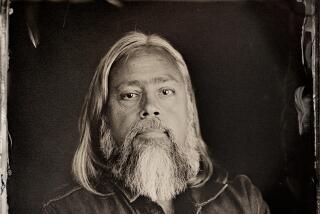All Dressed Up, With No Place to Go : The rapid and sure disappearance of ethnic garb is the motivation for world traveler Gloria LeBaron, whose photos are on view at UCI.
- Share via
Gloria LeBaron couldn’t agree more with those sentimental TV and print ads for camera film that urge one and all to “capture those special moments forever.”
As a world traveler who has watched people around the globe exchange their unique traditional garments for standard-issue Western denims and T-shirts, LeBaron has spent the past two decades photographing all manner of native garb before it vanishes.
“This stuff is going to go--you have to catch it at this moment,” said LeBaron, whose exhibition of 50 black-and-white photographs, “Vestiges of Ethnic Dress,” is on view at the UC Irvine Student Center’s Center Hall Gallery through Sept. 5.
“In the next century-- in a few years --many of these women will have already abandoned these traditions and become homogenous,” LeBaron said. “Tribes are being annihilated even as we speak. In some cases, it’s one tribe pitted against another; in others it’s by Westernization. Westernization comes in many forms, but they all do away with ethnic identity.”
Just this week, for example, the Arts & Entertainment cable channel aired footage of cannibals in Irian Jaya, on the island of New Guinea. The tribesmen, whose first contact with Westerners came in the 1980s, were shown rowing their canoes--and wearing T-shirts and jeans.
“Why is everybody wearing Levi’s? Maybe it’s not all bad, but if the costumes are going, maybe we’re also losing culinary techniques, the music and many other parts of these cultures,” LeBaron said. “The reason I got started was seeing the Levi’s all over Paris. I thought: ‘Is the whole world going to be wearing Levi’s?’ ”
The answer, she decided, was yes, so in 1974 she began to take photographs. Her background is not in photography; she’s a watercolorist with a master’s degree in art history from Cal State Los Angeles. She uses a Yashica camera that she bought for $100.
LeBaron has taught history, art and English as a second language at schools around the world, has lived in half a dozen countries and visited 35 others. She now lives in Leisure World near Laguna Hills.
*
The photos are grouped geographically: Highlights from Africa include a woman carrying logs in a remote area of Transkei in Southern Africa and a Masai mother and child near a mud-and-dung hut in Kenya.
“I’m always asked how I got some of these shots,” she said. “I got them because I’m old--72--and because I’m a woman. I’m no threat to anybody. My husband always stood back. He couldn’t have gotten these shots, but the women always welcomed me.”
Lebaron said that she’s only been in danger when she neglected her own safety, lingering perhaps a tad too long while a herd of camels came thundering toward her. But there have been difficulties.
In Iran, she said, “(I) spent many an hour in the bazaar at Shiraz trying to photograph the women without them noticing me. The Qashqai are nomads. I’d wait hours knowing certain groups were coming, or I’d go out in the desert and wait by the road for a caravan. Then I had to get the proper light.”
LeBaron mentioned the hot pinks, acid greens and vibrant blues of the Qashqai women’s clothes, and the fabrics shot through with metallic threads.
“They sparkle,” she said.
In that case, why shoot in black and white?
“Color fades,” she said.
The wall captions LeBaron wrote for the UCI exhibition are unabashedly subjective. One refers to the “drab” garb of Iranian women emerging from worship at a mosque, which raised the ire of some Muslim students at UCI. Rather than change her text, university administrators put up a disclaimer explaining that the opinions expressed are LeBaron’s.
Twenty years of photographing women have honed LeBaron’s concepts of beauty.
“I’d find women with body scarification carrying logs . . . yet it hadn’t taken from the real beauty and nobility of the woman. No tummy tucks, no implants, no face lifts--only unpretentiousness. . . . They adorn themselves in all manner of dress, but it’s their unpretentiousness that makes them beautiful.”
Mother-and-child portraits figure significantly in the show.
“Where women are not high on the monied scale, they’re usually tending children,” LeBaron said. “But not only tending children. Qashqai women set up the tent, cook the food, weave the rugs; other women trek all day with a kid on their shoulders, or sell at a little stall. If a man had to do what he (does) with a kid strapped on his back all the time. . . . “
*
Turning to her own culture, LeBaron says she by no means believes that motherhood precludes work outside the home.
“I juggled it,” she said. “I had a good occupation, and it can be done with a helpful husband. All of these women I’m taking pictures of, they’re working. They’re lugging crops, carrying logs, picking fruit, you name it. Women who stay home and don’t do anything--that’s a Western idea. There’s no reason women can’t have children and careers.”
LeBaron has two children and three grandchildren. Her daughter married a Norwegian, and she’s now visiting them in their home outside Oslo. While there, she hopes to get pictures of the indigenous people of Lapland, the Sames.
“It would be wonderful to finish my little job by the turn of the century,” she said. “But I’ll go until I drop dead.”
* “Vestiges of Ethnic Dress,” featuring 50 black-and-white photographs by Gloria LeBaron, is on display through Sept. 5 at the UC Irvine Student Center, Center Hall Gallery, Campus Drive and Bridge Road, Irvine. Free. (714) 725-2419.
More to Read
Sign up for The Wild
We’ll help you find the best places to hike, bike and run, as well as the perfect silent spots for meditation and yoga.
You may occasionally receive promotional content from the Los Angeles Times.






